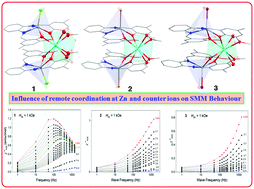Three new angular trinuclear Zn2Dy complexes, [Dy{Zn(L)Cl}2(H2O)2]Cl·3H2O (1), [Dy{Zn(L)Br}2(H2O)2](NO3)·6H2O (2) and [Dy{Zn(L)I}2(H2O)2](NO3)·6H2O (3), derived from a methyl substituted o-vanillin based Schiff base ligand, N,N′-bis(3-methoxy-5-methylsalicylidene)-1,2-phenylenediamine (H2L), have been synthesized and magneto-structurally characterised. In the complex cations in 1–3, the coordination environments of the Dy(III) ions are identical, but the apical coordination to the Zn(II) ion is different as it is bonded to different halide ions. Magnetic studies reveal that both 2 and 3 display field-supported slow magnetic relaxation, consistent with the isomorphic nature of the compounds, while 1 exhibits more pronounced single-molecule magnetic behaviour. The direct fitting of the experimental data as well as the analysis with CASSCF calculations and SINGLE_ANISO module reveals a variation in magnetic anisotropy within the series and the presence of weak antiferromagnetic intermolecular interactions. Therefore, the present report highlights the influence of remote coordination at Zn and counter ions on magnetic anisotropy and on intermolecular antiferromagnetic dipolar interactions, leading to distinct magnetic dynamics in these systems.

